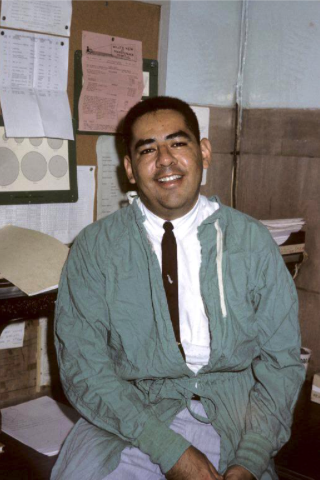By Gabriel Bell, Native Forward Alumna
When describing Dr. Beryl Blue Spruce (Pueblo of Laguna & Ohkay Owingeh), one would use words such as trail blazer and dedicated physician — but his impact is stretched beyond his professional achievements.
An obstetrician gynecologist, Blue Spruce was the first Native Pueblo physician and an advocate for Native health, particularly for Native women with limited resources. He broke many barriers and made strides as a Native doctor, leaving a legacy encouraging Native Scholars to follow in his footsteps and pursue careers in the medical field.
“Medicine is a field that requires every cell, every ability, every skill the human can possess,” Blue Spruce said in an address to aspiring Native scholars interested in pursuing health careers.
“If you are an artist, you can use that skill to be a physician. If you have a feeling for people, if you have a sense of being able to handle people and be comfortable with people, that’s a helpful asset in medicine. If you have an exceptional memory that’s helpful in medicine. What I am saying is that even though you might not have a straight ‘A’ average, you may have the attributes in other areas that will make you a great physician or a great nurse, or a great dentist or whatever it is you choose to be.”
With his career in medicine, Blue Spruce found fulfillment in doing what he loved to do: helping people.
In fact, his desire to help others continues to live on today through the Dr. Beryl Blue Spruce Memorial Scholarship Fund, Native Forward’s first scholarship endowment that was established in 1974 by the Blue Spruce family in his honor.
Over the years recipients of the scholarship have known the doctor’s name and through his son, Shawn Spruce, we learn more about his legacy and impact on Indian Country.
“He was really committed to people, regardless of the race,” Spruce said.
“My dad broke a lot of boundaries at time when there weren’t a lot of Native people doing what he was doing and making those kinds of strides professionally.”
It was the mid-1950s and a young Blue Spruce walked the halls of Stanford University as the only known Native student enrolled there. It was a different environment far from his home. Even then, the new college environment was challenging as he struggled through his coursework along with not having sufficient financial support. Overwhelmed with his circumstances, he left Stanford for some time to be home for a while.
After regaining his bearings, Blue Spruce soon returned to earn his degree from Stanford and later earn his medical degree from the University of Southern California (USC) in 1964. This was the beginning of his exceptional career as the first Native Pueblo physician.
It was also during this time that Blue Spruce met his wife, and they started a family. Spruce said that his father was a real comedian who enjoyed laughing and telling jokes. His father had an affinity for classical music and reading, along with a talent for building things with his hands.
Spruce shared many happy recollections of his father making Halloween costumes and decorating during the holiday season with his family. One particularly fond memory Spruce shared was when his father returned from a trip to Alaska and showed his children how to build an igloo in the snow.
Soon after he completed medical school at USC, Blue Spruce and his family moved to Philadelphia, Pennsylvania, for his residency in obstetrics and gynecology at Pennsylvania Hospital in 1967.
They then moved to Ann Arbor, Michigan, where he practiced his specialty while earning a Master of Public Health at the University of Michigan. By this time Blue Spruce held faculty appointments at University of Michigan medical school, University of Pennsylvania and Wayne State University in Detroit, Michigan. For a time, he was Special Assistant to the Director of the Indian Health Service (IHS) of the U.S. Public Health Service.
“My dad broke a lot of boundaries at time when there weren’t a lot of Native people doing what he was doing and making those kinds of strides professionally.”
About Shawn Spruce
In this capacity he was instrumental in creating a partnership with The American College of Obstetricians and Gynecologists (ACOG) and IHS to form the Native Women’s Health committee that focused on health of American Indian and Alaska Native women in 1970.
Blue Spruce recognized the disparity in healthcare for Native women, which is principally why he became an obstetrician-gynecologist.
Because of his leadership, ACOG and IHS have been able to conduct trainings and educational activities for IHS health care clinicians, offer site visits and expert consultations to over 150 maternal health hospital and improve women’s health for Native communities.
Blue Spruce was also an early advocate for Indigenous health professionals and the cultural and personal determinants of health behavior for Native people. His work extended beyond Indian Country as he provided healthcare to disadvantaged communities.
Many of these efforts were focused in the Detroit area, where he developed a maternity healthcare project for inner city families and a health center was later named after him.
Throughout his career, Blue Spruce made an unquestionable impact in the field of medicine. Yet it is his passion and dedication for helping others that will continue to pave the way for future Native scholars for years to come.
Read more articles like ‘Dr. Beryl Blue Spruce: Creating an Impact for Generations’ in the Spring 2021 edition of Native Forward Magazine.






